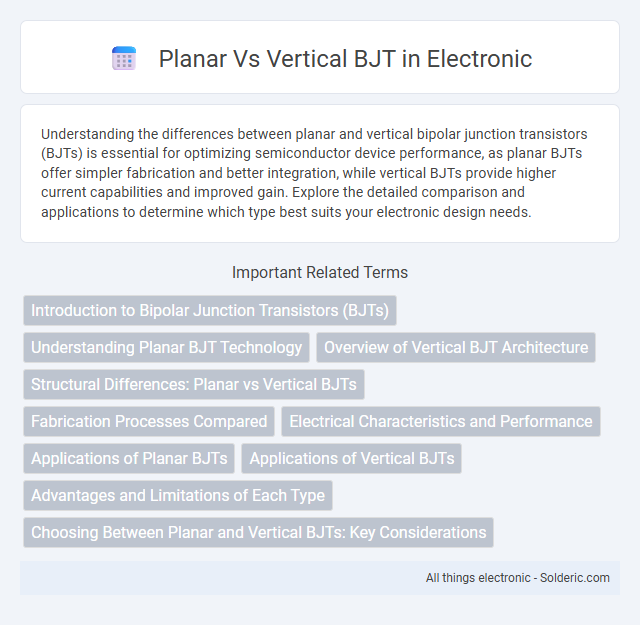Understanding the differences between planar and vertical bipolar junction transistors (BJTs) is essential for optimizing semiconductor device performance, as planar BJTs offer simpler fabrication and better integration, while vertical BJTs provide higher current capabilities and improved gain. Explore the detailed comparison and applications to determine which type best suits your electronic design needs.
Comparison Table
| Feature | Planar BJT | Vertical BJT |
|---|---|---|
| Structure | Lateral transistor with horizontal current flow | Current flows vertically through stacked layers |
| Current Flow | Horizontal (across the surface) | Vertical (through the substrate) |
| Fabrication | Surface diffusion and ion implantation on wafer surface | Uses epitaxial growth and deep diffusion |
| Current Handling | Limited due to planar geometry | Higher current capability due to vertical structure |
| Gain (b) | Moderate gain | Typically higher gain |
| Breakdown Voltage | Lower, due to shorter current path | Higher, due to vertical junction design |
| Applications | Small-signal amplification, integrated circuits | Power devices, high-current applications |
| Size | Compact, suitable for integrated circuits | Larger, optimized for power handling |
Introduction to Bipolar Junction Transistors (BJTs)
Bipolar Junction Transistors (BJTs) are semiconductor devices that amplify or switch electrical signals by utilizing both electron and hole charge carriers. Planar BJTs feature a lateral structure with junctions formed on a single plane, offering ease of fabrication and integration in integrated circuits. Vertical BJTs have a layered design allowing current to flow vertically through the device, enabling higher current density and improved performance in power applications.
Understanding Planar BJT Technology
Planar BJT technology involves fabricating transistors on a flat silicon wafer surface, where the emitter, base, and collector regions are formed laterally. This method offers enhanced manufacturing control, improved reliability, and scalability for integrated circuits compared to vertical BJTs. Understanding planar BJT technology helps you appreciate its role in modern microelectronics and optimized device performance.
Overview of Vertical BJT Architecture
The Vertical Bipolar Junction Transistor (BJT) features a layered semiconductor structure where current flows vertically from the emitter at the top through the base to the collector at the bottom, enabling higher current density and improved heat dissipation. Its architecture typically includes a heavily doped emitter, a thin base region, and a wide collector, optimized for high-frequency and high-power applications. This vertical design contrasts with planar BJTs by offering lower collector resistance and enhanced breakdown voltage, making it suitable for modern high-performance electronic devices.
Structural Differences: Planar vs Vertical BJTs
Planar BJTs feature a lateral layout where the emitter, base, and collector are formed on the same plane, resulting in simpler fabrication but limited current handling capacity. Vertical BJTs have a stacked structure with current flowing vertically through the layers, allowing for higher current densities and improved performance in power applications. Understanding these structural differences helps optimize Your design choices for specific electrical and thermal requirements.
Fabrication Processes Compared
Planar BJTs are fabricated using photolithography and diffusion techniques on a flat silicon wafer, allowing precise control over doping profiles with high scalability for mass production. Vertical BJTs rely on epitaxial growth and deep diffusion processes, creating a structure where current flows perpendicularly through multiple layers, optimizing high-frequency performance. Your choice in fabrication affects junction depth, collector efficiency, and device speed, critical for applications demanding speed versus integration density trade-offs.
Electrical Characteristics and Performance
Planar BJTs exhibit lower breakdown voltages and higher parasitic capacitances due to their lateral current flow, resulting in moderate frequency response and gain. Vertical BJTs feature vertical current flow through a thicker base region, enabling higher breakdown voltages, improved current gain (hFE), and enhanced frequency performance with reduced base resistance. The vertical structure typically supports better thermal dissipation and higher power handling, making it preferable in high-performance and high-frequency applications.
Applications of Planar BJTs
Planar BJTs are predominantly used in integrated circuits for analog and digital applications due to their ease of fabrication and compatibility with planar technology. They provide reliable performance in amplifiers, oscillators, and switching circuits within microprocessors and signal processing devices. Their widespread integration in CMOS technologies also makes them ideal for high-density semiconductor chips requiring efficient planar geometries.
Applications of Vertical BJTs
Vertical BJTs are widely used in power amplification and switching applications due to their high current handling capability and superior thermal performance compared to planar BJTs. Their structure allows for efficient heat dissipation, making them ideal for use in power management circuits, audio amplifiers, and motor control systems. If your design requires robust current conduction and reliable performance under high power conditions, vertical BJTs are the preferred choice.
Advantages and Limitations of Each Type
Planar BJTs offer superior thermal stability and higher current gain due to their well-established fabrication process, making them ideal for integrated circuits with low-noise applications. Vertical BJTs provide higher current density and better saturation voltage characteristics, which enhance performance in high-power and high-frequency devices, but they often face limitations in thermal dissipation and fabrication complexity. Understanding these trade-offs is crucial for optimizing device design based on application-specific requirements such as speed, power efficiency, and integration density.
Choosing Between Planar and Vertical BJTs: Key Considerations
Choosing between planar and vertical BJTs depends on factors such as current handling capacity, switching speed, and device size. Vertical BJTs offer higher current density and better performance in power applications due to their vertical structure, while planar BJTs are preferred for integrated circuits requiring lower current and faster switching. Design constraints, thermal management, and cost also influence the selection process between planar and vertical transistor technologies.
Planar vs Vertical BJT Infographic

 solderic.com
solderic.com